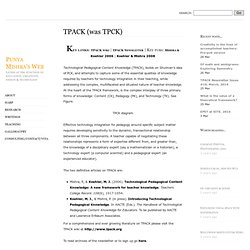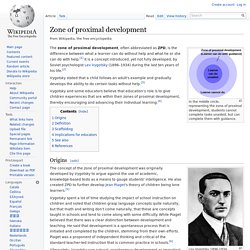

TPACK (was TPCK) Key links: TPACK wiki | TPACK Newsletter | Key pubs: Mishra & Koehler 2006 | Koehler & Mishra 2008 Technological Pedagogical Content Knowledge (TPACK), builds on Shulman’s idea of PCK, and attempts to capture some of the essential qualities of knowledge required by teachers for technology integration in their teaching, while addressing the complex, multifaceted and situated nature of teacher knowledge.

At the heart of the TPACK framework, is the complex interplay of three primary forms of knowledge: Content (CK), Pedagogy (PK), and Technology (TK). See Figure. Effective technology integration for pedagogy around specific subject matter requires developing sensitivity to the dynamic, transactional relationship between all three components. The two definitive articles on TPACK are: For a comprehensive and ever growing literature on TPACK please visit the TPACK wiki at. TPaCK and Kinesthetic learning. Memory. Mem PPT Ed Psy. Zone of proximal development. In the middle circle, representing the zone of proximal development, students cannot complete tasks unaided, but can complete them with guidance.

The zone of proximal development, often abbreviated as ZPD, is the difference between what a learner can do without help and what he or she can do with help.[1] It is a concept introduced, yet not fully developed, by Soviet psychologist Lev Vygotsky (1896–1934) during the last ten years of his life.[2] Vygotsky stated that a child follows an adult's example and gradually develops the ability to do certain tasks without help.[3] Vygotsky and some educators believe that education's role is to give children experiences that are within their zones of proximal development, thereby encouraging and advancing their individual learning.[4] Origins[edit] The concept of the zone of proximal development was originally developed by Vygotsky to argue against the use of academic, knowledge-based tests as a means to gauge students' intelligence.
Definition[edit] Vygotsky's Cog. Development ZPD. Learning styles. Learning style is an individual's natural or habitual pattern of acquiring and processing information in learning situations.

A core concept is that individuals differ in how they learn.[1] The idea of individualized learning styles originated in the 1970s, and has greatly influenced education.[2] Proponents of the use of learning styles in education recommend that teachers assess the learning styles of their students and adapt their classroom methods to best fit each student's learning style. Although there is ample evidence for differences in individual thinking and ways of processing various types of information, few studies have reliably tested the validity of using learning styles in education.[2] Critics say there is no evidence that identifying an individual student's learning style produces better outcomes. David Kolb's model[edit] David A. David Kolb’s Experiential Learning Model (ELM) [5] 1. 2. 3. 4. Learning Modalities[edit] 1. 2. 3. Kinesthetic learning. Kinesthetic learning (also known as Tactile learning) is a learning style in which learning takes place by the student carrying out a physical activity, rather than listening to a lecture or watching a demonstration.

People with a preference for kinesthetic learning are also commonly known as "do-ers". Tactile-kinesthetic learners make up about five percent of the population.[1] The Fleming VAK/VARK model (one of the most common and widely used categorizations of the various types of learning styles)[2] categorized learning styles as follows: History[edit] Kinesthetic intelligence was originally coupled with tactile abilities, and was defined and discussed in Howard Gardner's Frames Of Mind: The Theory of Multiple Intelligences.
In his book, Gardner describes activities (such as dancing and performing surgery) as requiring great kinesthetic intelligence: using the body to create (or do) something. Sigcse-2004-kla-special-session. Student Learning Preferences and Teaching Implications. © 2004 American Dental Education Association + Author Affiliations Direct correspondence and requests for reprints to Mr.

Robert J. Murphy, Department of Pathology and Laboratory Medicine, Temple University Hospital, Broad Street, Philadelphia, PA 190140; 215-707-3466 phone; 215-707-2053 fax; murphyrj@tuhs.temple.edu. Received March 11, 2004. Abstract One of the most serious challenges that dental educators face today is improving the level of student satisfaction with the curriculum and learning environment. Keywords: One of the most serious challenges that dental educators face today is improving the level of student satisfaction with the curriculum and learning environment. On any given day in dental school, absenteeism from lecture can be a serious concern for dental faculty. Visual learning is broken into a second category called Read/Write. Aural learners concentrate on what lecturers say. Methods Results Table 1. Table 2. Table 3. Table 4. Table 5. Table 6. Table 7.
Table 8. Discussion. CERT123002009.